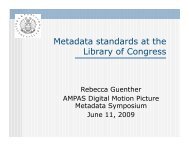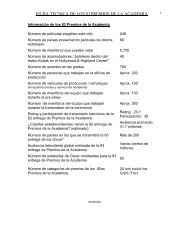Download Report - Academy of Motion Picture Arts and Sciences
Download Report - Academy of Motion Picture Arts and Sciences
Download Report - Academy of Motion Picture Arts and Sciences
You also want an ePaper? Increase the reach of your titles
YUMPU automatically turns print PDFs into web optimized ePapers that Google loves.
I<br />
The<br />
relative amount <strong>of</strong> energy at different wavelengths<br />
depends upon the temperature at which the<br />
filament is operated. The curve marked 2800 shows<br />
the spectral distribution <strong>of</strong> energy emitted by inc<strong>and</strong>escentungsten<br />
when operated at a color temperature<br />
<strong>of</strong> 2800'K. This is approximately the<br />
temperature at which the smaller sizes <strong>of</strong> commercial<br />
Mazda lamps are operated. In the case <strong>of</strong><br />
the larger units such as the 3,000, 5,000 <strong>and</strong> 10,000-<br />
watt lamps designed specifically for use in motion<br />
picture studios, the filament is operated at a much<br />
higher temperature, in some cases reaching a value<br />
<strong>of</strong> 3200'K. The distribution <strong>of</strong> energy in the radiation<br />
from such a lamp is shown by the curve in Fig.<br />
2, designated as 3200. The curve indicates that<br />
there is a great preponderance <strong>of</strong> radiation in the<br />
long wave-length region o{ the visible spectrum,<br />
that is between 550 <strong>and</strong> 700 mp. The curve slopes<br />
rapidly downward {or shorter wave-lengths, reaching<br />
a very low value at 300 mp,. The portion <strong>of</strong><br />
the radiation lying in the ultra-violet between 300<br />
<strong>and</strong> 400 mp is relatively small as compared with<br />
that in the visible resion.<br />
h<br />
d<br />
z<br />
EF<br />
1<br />
d<br />
\^AVE LErcTH lN n,/[<br />
FIGURE<br />
Spectral distribution <strong>of</strong> energy in radiation from ordinary<br />
carbon arc. The small circles show the distribution <strong>of</strong> energy<br />
in the radiation from a black body at 40000 K.<br />
III<br />
0<br />
z<br />
=<br />
t<br />
E<br />
t":::lifi":llr:f xt"'"'"";ff i,:"<br />
tt..?uilt:?<br />
f ::?:i.i#o:i:l'"<br />
"r"u*" -,u'<br />
identical, approaches fairly closely that for sunlight<br />
<strong>and</strong> judeed visually the light from the high intenJity<br />
arc matches approximately sunlight in co-ior. Therl<br />
is a large proportion <strong>of</strong> the shorter. visible wavelengths<br />
present <strong>and</strong> although it is not shown in the<br />
figure, it is well known that such sources emit a<br />
relatively high intensity o{ radiation in the ultraviolet<br />
between 300 <strong>and</strong> 400 mu.<br />
In the case <strong>of</strong> the flame ur.i, it is difficult to define<br />
the spectral composition in terms <strong>of</strong> curves similar<br />
to those shown in the illustrations already given.<br />
As stated previously, the spectral composition <strong>of</strong><br />
these flame arcs tends to be <strong>of</strong> the b<strong>and</strong>ed or line<br />
type with numerous very high maximum ano very<br />
low minimum intensities at certain wave-lengths.<br />
Spectral composition can in these cases be more<br />
easily shown by dispersing the radiation by means<br />
<strong>of</strong> a prism or grating <strong>and</strong> making photographs <strong>of</strong><br />
the spectrum thus formed. While these cannot so<br />
easily be interpreted quantitatively as the spectro-<br />
I<br />
i<br />
i<br />
I<br />
t<br />
L<br />
In Fig. 3 the curve shows the distribution <strong>of</strong><br />
energy from the crater <strong>of</strong> a low intensity carbon<br />
arc, such as has been used extensively in the motion<br />
picture studios <strong>and</strong> commonly referred to as Kleigs,<br />
spots, elr. A comparison <strong>of</strong> this curve with that<br />
for inc<strong>and</strong>escent tungsten in Fig. 2 shows the presence<br />
<strong>of</strong> a relaively greater proportion <strong>of</strong> the shorter<br />
wave-length radiation. It follows, therefore, that<br />
the light from such an arc is bluer than that emitted<br />
by tungsten.<br />
Fig, 4 shows the spectrophotometric curve for the<br />
high intensity carbon arc, commonly referred to as<br />
the sun arc. In this case the electrical conditions<br />
<strong>and</strong> the composition <strong>of</strong> the carbons used are such<br />
that the spectral composition <strong>of</strong> radiation is markedly<br />
difierent from that emitted by the ordinary low<br />
intensity carbon arc illustrated in Fig. 3. The maximum<br />
has in this case moved over to about 530 mp,<br />
which is approaching the wave-length <strong>of</strong> the maximum<br />
for sunlight. In fact, the curve, while not<br />
[31 ]<br />
r<br />
D<br />
FIGURE<br />
Wedeie spectrograms showing the relative ristribution <strong>of</strong><br />
energy in the radiation from various flame arcs: (A) sunlight,<br />
(B) acetylene ame, (C ) white ame arc, (D) blue flame<br />
arc, (E) yellow flame arc, (F) red flame arc.<br />
V
















